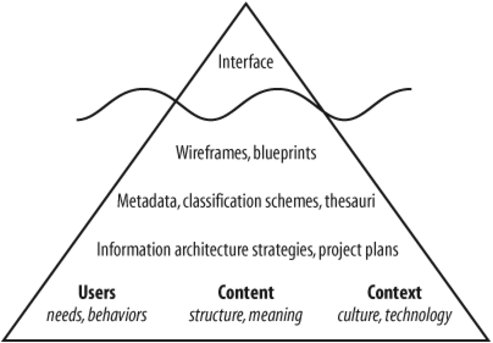Section 18.9. The End of the Beginning
18.9. The End of the BeginningAs information architects, we can also use invisibility to our advantage. There is no question that our discipline suffers from the iceberg problem, as illustrated in Figure 18-8. Most of our clients and colleagues focus on the interface, without appreciating the underlying structure and semantics. Figure 18-8. The information architecture iceberg Savvy designers know to look beneath the water line, understanding the importance of blueprints and wireframes to site development. But few people, even within the web design community, realize the critical role the lower layers play in building a successful user experience. This ignorance of deep information architecture results in short, superficial, and often doomed projects. Those who recognize the need to build structures from the bottom up have an immediate advantage over those who skim along the surface. And because this structural design is hidden from the outside world, these early adopters get a big head start. Once competitors see what the Episcopalians call "the outward and visible signs of inward and spiritual grace," it's often too late. By the time Borders Books & Music realized the power of Amazon's user experience, they were already years behind. But invisibility doesn't automatically confer sustainable advantage. In today's fast and fluid economy, easily duplicated best practices spread like wildfire. This is why companies can no longer look to technology for their salvation. By lowering the barrier to entry and fostering open standards, the Internet has created a more level playing field. Michael Porter says it best in a Harvard Business Review article:[§]
As all companies come to embrace Internet technology, the Internet itself will be neutralized as a source of advantage. Basic Internet applications will become table stakescompanies will not be able to survive without them, but they will not gain any advantage from them. Today's cutting-edge technology is tomorrow's commodity. If it can be copied, it will be copied. Porter goes on to explain: To gain these advantages, companies need to stop their rush to adopt generic "out of the box" packaged applications and instead tailor their deployment of Internet technology to their particular strategies. Although it remains more difficult to customize packaged applications, the very difficulty of the task contributes to the sustainability of the resulting competitive advantage. That last line resonates strongly in the context of information architecture. In effect, we can transform the invisibility and difficulty of our work from a liability into an asset. The possibilities for aligning information architecture and business strategy to produce sustainable competitive advantage are exhilarating. We have much to learn, and we've only just begun. When we look back many years from now, we will chuckle at the foolishness of our earliest efforts on the Web. We will wonder how we ever thought that information architecture and business strategy could exist independently. We haven't yet figured out all the answers, but at least we're starting to ask the right questions. As Winston Churchill once said, "This is not the end. It is not even the beginning of the end. But it is, perhaps, the end of the beginning." |
EAN: 2147483647
Pages: 194